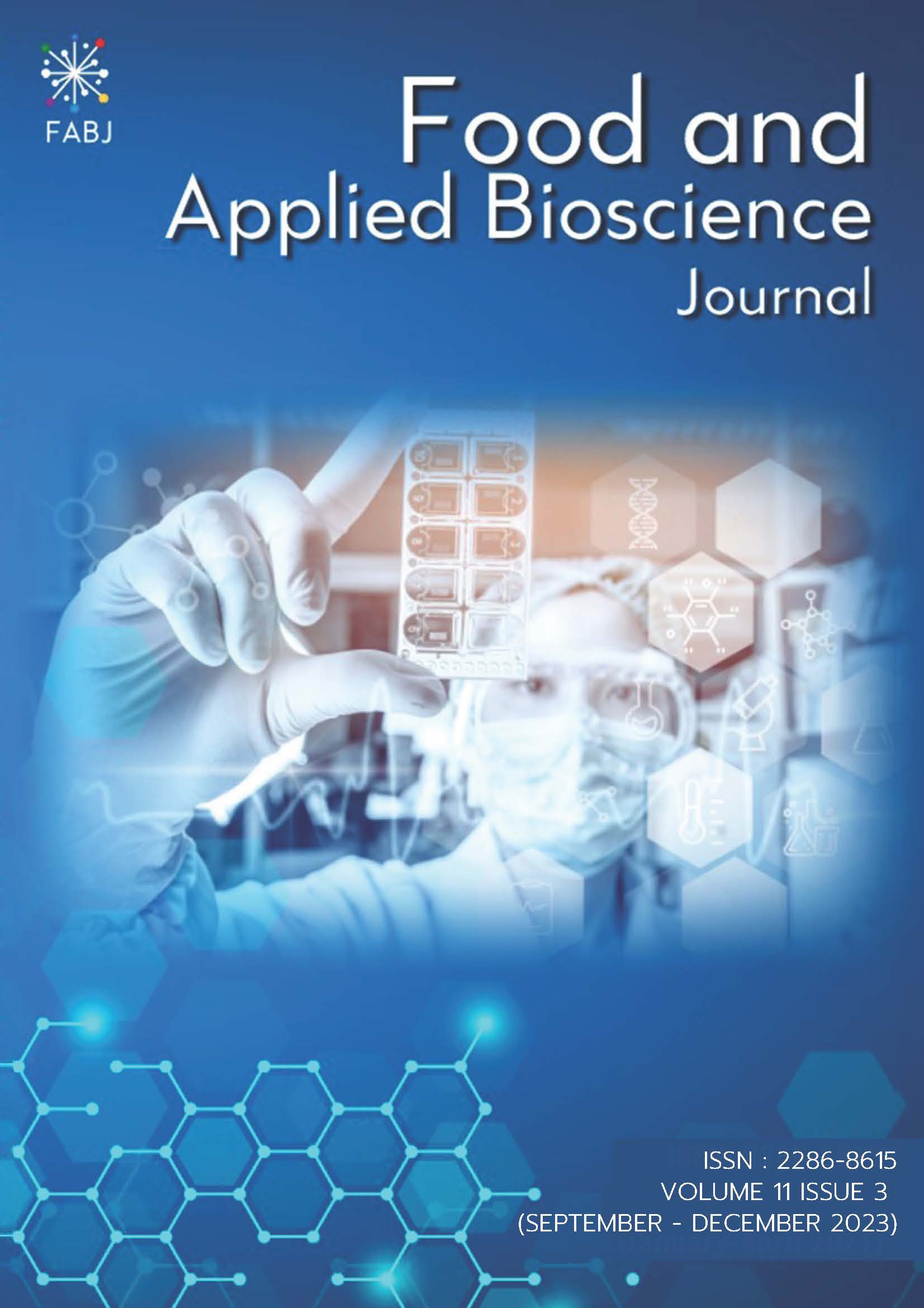Utilization of ultrasonic-assisted extraction for antioxidants isolation from black rice and its impact on the characteristics of chitosan films
Utilization of ultrasonic-assisted extraction for antioxidants isolation from black rice bran and its impact on the characteristics of chitosan films
Keywords:
Anthocyanin, Extraction, Film, Chitosan, Black rice bran, UltrasoundAbstract
Black rice bran is rich in anthocyanins and phenolic compounds, both renowned for their potent antioxidant properties. The use of ultrasound technology in combination with solvent extraction has the potential to increase the efficiency of extracting antioxidants from black rice bran. This study was conducted to investigate the optimal conditions for the extraction of antioxidants from black rice bran using ultrasonic-assisted extraction. Four key factors were examined: the rice bran-to-solvent ratio (1:13-1:27 w/v), extraction time (16-44 min), power intensity (25-95% amplitude), and pulse duration (1-9 seconds). The rice bran-to-solvent ratio and extraction duration exhibited a significant influence on DPPH radical scavenging activity, whereas power intensity and pulse duration notably impacted the total phenolic content and DPPH radical scavenging activity. The optimal extraction conditions were determined to be a 1:15 ratio of rice bran to solvent, a 20 min extraction duration, 66% amplitude, and a 3-second pulse. Under these conditions, the extraction yielded total phenolic and anthocyanin contents of 12.41 mg/g and 3.88 mg/g, respectively, with a DPPH radical scavenging activity (IC50) of 63.19 mg/g. Chitosan films infused with the black rice bran extract exhibited reduced tensile strength compared to the control. The incorporation of glycerol, known to enhance film flexibility, resulted in increased elongation at break. Interestingly, the addition of the extract did not significantly alter the elongation at break but led to a decrease in L* and b* values and an increase in a* value of the chitosan films. The findings of this study demonstrate the potential for enhancing the extraction efficiency of antioxidative compounds from black rice bran through ultrasound technology, leading to the production of chitosan films incorporating black rice bran anthocyanins potentially to be utilized as a pH-sensitive indicator film
References
Ahmed, J., Mulla, M. Z., and Arfat, Y.A. 2016. Thermo-mechanical, structural characterization and antibacterial performance of solvent casted polylactide/cinnamon oil composite films. Food Control. 69: 196-204.
Brand-Williams, W., Cuvelier, M. E., and Berset, C. 1995. Use of a free radical method to evaluate antioxidant activity. LWT - Food Science and Technology. 28: 25-30.
Chen, F., Sun, Y., Zhao, G., Liao, X., Hu, X., Wu, J., and Wang, Z. 2007. Optimization of ultrasound-assisted extraction of anthocyanins in red raspberries and identification of anthocyanins in extract using high-performance liquid chromatography–mass spectrometry. Ultrasonics Sonochemistry. 14: 767-778.
Dick, M., Costa, T. M. H., Gomaa, A., Subirade, M., Rios, A. O., and Flores, S. H. 2015. Edible film production from chia seed mucilage: Effect of glycerol concentration on its physicochemical and mechanical properties. Carbohydrate Polymers. 130: 198-205.
Fabian, C., Tran-Thi, N. Y., Kasim, N. S., and Ju, Y. 2010. Release of phenolic acids from defatted rice bran by subcritical water treatment. Journal of the Science of Food and Agriculture. 90: 2576-2581.
Giusti, M. M. and Wrolstad, R. E. 2001. Characterization and measurement of anthocyanins by UV–visible spectroscopy. In R. E. Wrolstad, (Ed.), Current Protocols in Food Analytical Chemistry. pp. F1.2.1–F1.2.13. Wiley: New York, USA.
Hossain, M. B., Brunton, N. P., Patras, A., Tiwari, B., O’Donnell, C. P., Martin-Diana, A. B. and Barry-Ryan, C. 2012. Optimization of ultrasound assisted extraction of antioxidant compounds from marjoram (Origanum majorana L.) using response surface methodology. Ultrasonics Sonochemistry. 19(3): 582-590.
Huang, W., Xue, A., Niu, H., and Jia, Z. 2009. Optimised ultrasonic-assisted extraction of flavonoids from Folium eucommiae and evaluation of antioxidant activity in multi-test systems in vitro. Food Chemistry. 114(3): 1147-1154.
Ichikawa, H., Ichiyanagi, T., Xu, B., Yoshii, Yoichi, Nakajima, M., and Konishi, T. 2001. Antioxidant activity of anthocyanin extract from purple black rice. Journal of Medicinal Food. 4: 211-218.
Kanha, N., Osiriphun, S., Rakariyatham, K., Klangpetch, W., and Laokuldilok, T. 2022. On-package indicator films based on natural pigments and polysaccharides for monitoring food quality: a review. Journal of the Science Food and Agriculture. 102(15): 6804-6823. DOI 10.1002/jsfa.12076.
Khan, M.K., Abert-Vian, M., Fabiano-Tixier, A.S., Dangles, O., and Chemat, F. 2010. Ultrasonic-assisted extraction of polyphenols (flavanone glycosides) from orange (Citrus sinensis L.) peel. Food Chemistry. 119: 851-858.
Laohakunjit, N., and Noomhorm, A. 2004. Effect of plasticizers on mechanical and barrier properties of rice starch film. Starch-Starke Journal. 56: 348-356.
Miliauskas G., Venskutonis, P. R., and van Beek, T. A. 2004. Screening of radical scavenging activity of some medicinal and aromatic plant extracts. Food Chemistry. 85: 231-237.
Muangrat, R., Pongsirikul, I., and Blanco, P. H. 2018. Ultrasound assisted extraction of anthocyanins and total phenolic compounds from dried cob of purple waxy corn using response surface methodology. Journal of Food Processing and Preservation. 42(2): e13447.
Tiwari, B. K., Patras, A., Brunton, N., Cullen, P. J., and O’Donnell, C. P. 2010. Effect of ultrasound processing on anthocyanins and color of red grape juice. Ultrasonics Sonochemistry. 17(3): 598-604.
Toma, M., Vinatoru, M., Paniwnyk, L., and Mason, T. 2001. Investigation of the effects of ultrasound on vegetal tissues during solvent extraction. Ultrasonics Sonochemistry. 8(2): 137-142.
Vilkhu, K., Mawson, R., Simons, L., and Bates, D. 2008. Applications and opportunities for ultrasound-assisted extraction in the food industry - A review. Innovative Food Science & Emerging Technologies. 9(2): 161-169.
Wan, Y., Creber, A.M., Peppley, B., and Bui, V.T. 2003. Ionic conductivity of chitosan membranes. Polymer. 44: 1057-1065.
Yoshida, C. M. P., Maciel, V. B. V., Mendonça, M. E. D., and Franco, T. T. 2014. Chitosan biobased and intelligent films: monitoring pH variations. LWT – Food Science and Technology. 55(1): 83–89.
Zhang, X., Liu, Y., Yong, H., Qin, Y., Liu, J., and Liu, J. 2019. Development of multifunctional food packaging films based on chitosan, TiO2 nanoparticles and anthocyanin-rich black plum peel extract. Food Hydrocolloids. 94: 80–92.
Downloads
Published
How to Cite
Issue
Section
License
Copyright (c) 2022 Food and Applied Bioscience Journal

This work is licensed under a Creative Commons Attribution-NonCommercial-NoDerivatives 4.0 International License.






